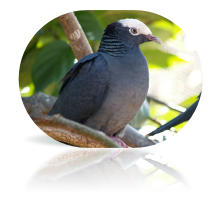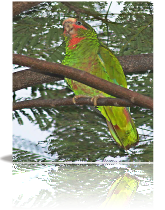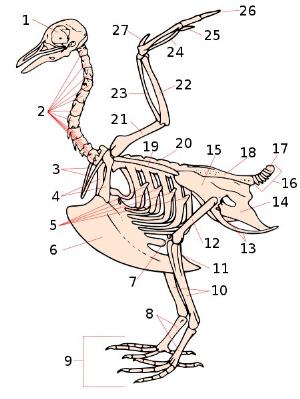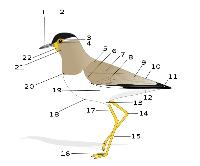
Bird AnatomyBird anatomy, or the physiological structure of birds' bodies, shows many unique adaptations, mostly aiding flight. Birds have a light skeletal system and light but powerful musculature which, along with circulatory and respiratory systems capable of very high metabolic rates and oxygen supply, permit the bird to fly. The development of a beak has led to evolution of a specially adapted digestive system. These anatomical specializations have earned birds their own class in the vertebratephylum. The bird skeleton is highly adapted for flight. It is extremely lightweight but strong enough to withstand the stresses of taking off, flying, and landing.
(Click on image to enlarge)
Skeletal system of a
dove: 1 skull 2 cervical vertebrae
3 furcula 4 coracoid 5 uncinate processes of ribs 6 keel
7 patella 8 tarsometatarsus
9 digits 10 tibia (tibiotarsus)
11 fibia (tibiotarsus) 12 femur
13 ischium (innominate) 14 pubis
(innominate) 15 illium (innominate) 16 caudal vertebrae 17 pygostyle 18 synsacrum 19 scapula 20 lumbar vertebrae 21 humerus 22 ulna 23 radius 24 carpus 25 metacarpus 26 digits 27 alula
(Click on image to enlarge)
External anatomy (topography) of a typical bird: 1 Beak, 2 Head, 3 Iris, 4 Pupil, 5 Mantle, 6 Lesser coverts, 7 Scapulars, 8 Coverts, 9 Tertials, 10 Rump,
11 Primaries, 12 Vent, 13 Thigh, 14 Tibio-tarsal articulation,
15 Tarsus, 16 Feet, 17 Tibia, 18 Belly, 19 Flanks, 20 Breast, 21 Throat, 22 Wattle
| |
|

Grand Caymanian Parrot (Amazona leucocephala caymanensis)

|
Copyright © 2011, Caymannature.com. All rights reserved.


